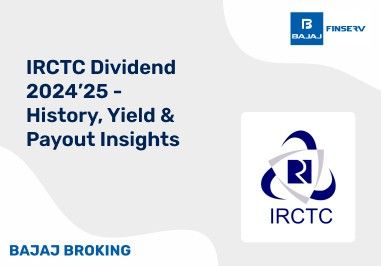BAJAJ BROKING
Tankup Engineers IPO is Open!
Open a Free Demat Account
Trade Now, Pay Later with up to 4x
Track Market Movers Instantly
What is Ticker Tape in the Share Market? - Meaning and History
Synopsis:
Reminiscent of the original paper ribbon that showed quotes of stock prices and trades in the 19th and 20th centuries, ticker tape is a linear method by which investors gain knowledge about changes in stock prices, trades conducted, and volume. Now, evolved from its original analogue method of display, the interface of ticker tape is digital.
If you know an experienced trader or investor that has traded and invested in the stock market for decades, they may have something to say about a mechanism called ticker tape. When trading was conducted physically, a linear display of trades conducted, stock price quotes, and trading volumes would show up on a linear display, giving all the information about trading conducted.
Article Highlights
The article that follows delves into the areas highlighted below:
- What is ticker tape in the share market?
- The History of Ticker Tape
- Advanced Machines
What is Ticker Tape in the Share Market?
In terms of the share market, whether investors want to refer to futures and options in the share market, or stock prices in general, the ticker tape is a continuously moving linear display, now digital, that shows prices of stocks. This is a display that portrays information about stocks sold and bought, volumes, and relevant prices in real time. All the market data that is exhibited on the ticker tape is done so through the use of computers and the ticker tape is a global indicator of prices in stock exchanges. In previous times, before digitisation made itself known, the ticker tape was an analogue display and worked on a mechanism to constantly show market information.
The History of the Ticker Tape
Today, ticker tape meaning takes on a new avatar as the ticker tape in today’s markets are all digitally and electronically controlled. The first ticker tapes, the devices that worked mechanically before the advent of technology, were seen in the 19th century, and these printed numeric data with corresponding stock symbols to send relevant trade information which was transmitted via telegraph wires. The current ticker tapes used are digital but the name has stuck due to the sound of mechanical ticking that early analogue machines made. Additionally, the name also derives its meaning from the long pieces of paper that looked like ribbons, that the quotes of stock prices were originally printed on.
The first ticker tape that worked akin to a telegraph machine was invented by Edward Calahan in 1867. Thomas Edison enhanced Calahan’s revolutionary invention in 1871, and patented it. The initial ticker tape used specific keyboards that turned stock data into morse code. This was then read by a machine at the receiving end of the message.
Advanced Machines
Ticker tape share price machines that were introduced later, in 1930 and 1964, were faster than their predecessors by double the rate. However, they still displayed a delay of 15-20 minutes between the time that transactions were conducted and the time when they were recorded. In the 1960s, the ticker tape that was once mechanical, became electronic. In the latter part of the 19th century, it was a common practice for brokers trading at the New York Stock Exchange to have their offices close to the exchange as this assured them a steady supply of information through the ticker tape, and the latest stock transactions conducted.
In 1996, the ticker tape saw its revolutionary advancement into a real-time machine. The ticker tape in the share market was now relaying data in real time. With these up-to-the-moment figures of transactions, like those of volume and price, brokers had a field day as trading became easier with such information. These updates were relayed by messengers (‘pad shovers’). They ran a circuit that would travel between the exchange trading floor and the offices of the brokers. Consequently, those brokers who were located closer to the exchange (with a shorter distance for the message to travel) had more advantage with the latest information than those brokers further away.
What investors see on TV news broadcasts, websites, and financial wires now, are the latest version of the advanced ticker tape with real-time information. Investors read ticker tapes through the identification of the stock symbol of the ticker on the exchange. Near the symbol will be the last traded price, and then a sign for the volume, showing an arrow (actually a triangle) up or down relative to a change in the stock price from the stock’s opening price.
Conclusion
Ticker tape has been a boon for traders and investors who use it to indicate the performance of a stock or to analyse data and plan future trades. Ticker tape shows investors a stock’s current price and the change in the price, plus the traded volume. While technical analysts use charts to educate themselves about stock data, ticker tape information is a component of this analysis.
Additional Read: Technical Analysis in the Share Market
Disclaimer: Investments in the securities market are subject to market risk, read all related documents carefully before investing.
This content is for educational purposes only. Securities quoted are exemplary and not recommendatory.
For All Disclaimers Click Here: https://bit.ly/3Tcsfuc
Share this article:
Read More Blogs
Disclaimer :
The information on this website is provided on "AS IS" basis. Bajaj Broking (BFSL) does not warrant the accuracy of the information given herein, either expressly or impliedly, for any particular purpose and expressly disclaims any warranties of merchantability or suitability for any particular purpose. While BFSL strives to ensure accuracy, it does not guarantee the completeness, reliability, or timeliness of the information. Users are advised to independently verify details and stay updated with any changes.
The information provided on this website is for general informational purposes only and is subject to change without prior notice. BFSL shall not be responsible for any consequences arising from reliance on the information provided herein and shall not be held responsible for all or any actions that may subsequently result in any loss, damage and or liability. Interest rates, fees, and charges etc., are revised from time to time, for the latest details please refer to our Pricing page.
Neither the information, nor any opinion contained in this website constitutes a solicitation or offer by BFSL or its affiliates to buy or sell any securities, futures, options or other financial instruments or provide any investment advice or service.
BFSL is acting as distributor for non-broking products/ services such as IPO, Mutual Fund, Insurance, PMS, and NPS. These are not Exchange Traded Products. For more details on risk factors, terms and conditions please read the sales brochure carefully before investing.
Investments in the securities market are subject to market risk, read all related documents carefully before investing. This content is for educational purposes only. Securities quoted are exemplary and not recommendatory.
For more disclaimer, check here : https://www.bajajbroking.in/disclaimer
Our Secure Trading Platforms
Level up your stock market experience: Download the Bajaj Broking App for effortless investing and trading













